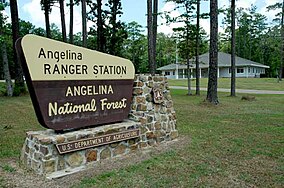Angelina National Forest
In the world of Angelina National Forest, there are an infinite number of aspects and approaches to address. Whether in everyday life, in the workplace, or in society in general, Angelina National Forest has a significant impact on our lives. From its origins to its evolution today, Angelina National Forest has been the object of study, debate and reflection. In this article, we will explore different perspectives on Angelina National Forest, analyzing its importance, implications and influence in various contexts. Through a comprehensive and multidisciplinary approach, we will shed light on this topic to foster a more complete and enriching understanding of Angelina National Forest.
| Angelina National Forest | |
|---|---|
 | |
| Location | Texas, USA |
| Nearest city | Lufkin, TX |
| Coordinates | 31°16′07″N 94°24′43″W / 31.26861°N 94.41194°W |
| Area | 153,180 acres (619.9 km2) |
| Established | October 13, 1936 |
| Governing body | U.S. Forest Service |
| Website | National Forests in Texas |


Angelina National Forest is a United States National Forest, one of four located in the piney woods region of Texas. The 153,180-acre (619.9 km2) Angelina National Forest is located in East Texas in parts of San Augustine, Angelina, Jasper and Nacogdoches counties. It is managed together with the three other National Forests in Texas (Davy Crockett, Sabine, and Sam Houston) from Forest Service offices in Lufkin, Texas. There are local district offices located in Zavalla. The forest lies in the Neches River Basin and on the north and south shores of Sam Rayburn Reservoir. Longleaf pine is the predominant cover type in the southern portion of the forest, while loblolly and shortleaf pine are dominant species in the northern portion and abundant throughout.
History
Humans came to the area around 8,000 years ago. Archeological sites document the evidence of man's presence over the entire period since then.
In 1934, the Texas Legislature approved a resolution to urge federal purchase of land to create National Forests in Texas. In 1935, acquisition began on the Davy Crockett, Sam Houston, Sabine and Angelina National Forests.
Wildlife
Hundreds of wildlife species exist in the forest. Principal game species include white-tailed deer, squirrel, wild turkey, American woodcock, bobwhite quail, mourning dove and wood duck. The forest provides wintering habitat for the bald eagle. The red-cockaded woodpecker, an endangered species, is found throughout the forest.
Wilderness areas
There are two officially designated wilderness areas lying within Angelina National Forest that are part of the National Wilderness Preservation System.
See also
References
- ^ a b c "Land Areas of the National Forest System" (PDF). U.S. Forest Service. Retrieved 2012-03-20.
- ^ "The National Forests of the United States" (PDF). ForestHistory.org. Retrieved July 30, 2012.
- ^ "RED-COCKADED WOODPECKER". The Texas Breeding Bird Atlas. Retrieved 2022-04-11.
External links
- Angelina National Forest USDA Forest Service - National Forests & Grasslands in Texas
- Christopher Long: Angelina National Forest from the Handbook of Texas Online. Retrieved December 23, 2008.
